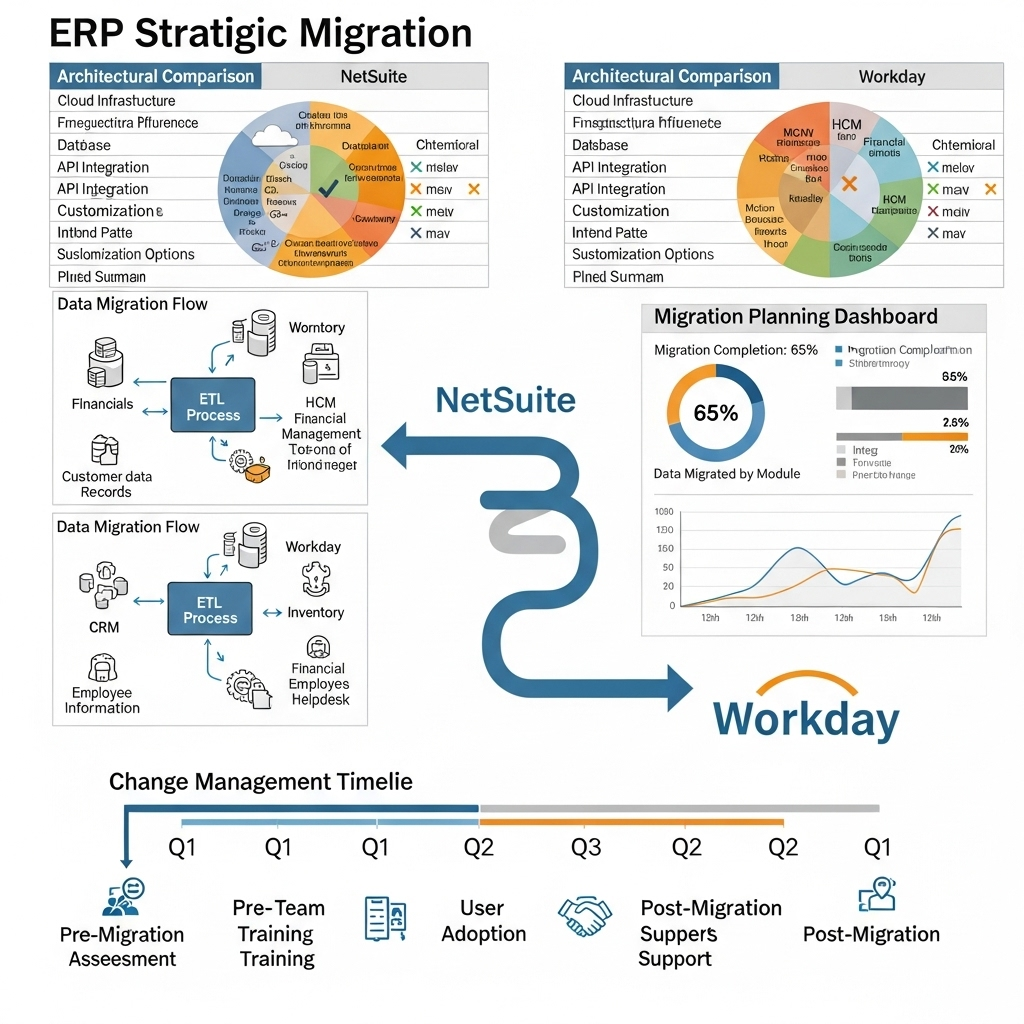
Table of Contents
Beyond Implementation: The Cloud-to-Cloud ERP Migration Decision
While much analysis focuses on initial ERP selection or migrating from legacy on-premise systems, an increasingly relevant scenario involves organizations moving between established cloud ERP platforms. My research indicates that these migrations are rarely simple “lift-and-shift” operations; they’re driven by significant strategic shifts and require careful consideration beyond technical feasibility. Using a hypothetical migration from NetSuite to Workday Financials as an example framework, let’s analyze the core strategic factors involved.
Why would a company already invested in a robust cloud ERP like NetSuite consider a move to another major player like Workday Financials? Common drivers include fundamental changes in business operating models (e.g., shifting towards services or subscriptions), evolving scalability requirements exceeding the current platform’s optimal range, significant functional gaps hindering strategic initiatives (often related to integrated HCM or advanced planning), or post-merger platform consolidation mandates.
Core Strategic Comparison Points
The decision hinges on how well each platform aligns with the organization’s future state, not just its current needs. Key areas requiring deep analysis include:
- Architectural Philosophy: Understanding the difference between NetSuite’s integrated suite approach and Workday’s unified data model with its emphasis on Worktags is crucial. Does the organization benefit more from broader, pre-integrated functionality or a highly flexible, dimension-driven reporting structure? (My previous analysis comparing these platforms delves deeper into these differences).
- Functional Strengths & Gaps: Objectively assess which platform better supports critical future-state processes. Workday often holds an edge in unified HCM/Finance, while NetSuite might offer stronger inventory or manufacturing capabilities depending on the modules licensed. Does the potential gain in one area outweigh potential compromises elsewhere?
- Customization & Integration Ecosystem: Evaluate the long-term implications of each platform’s approach to customization and the maturity of their respective integration marketplaces (e.g., SuiteCloud vs. Workday Cloud Platform).
Data Migration: More Than Just Mapping
Migrating substantial volumes of financial data between two sophisticated cloud ERP systems presents unique and often underestimated challenges. It’s not merely a technical exercise of mapping fields from the source (e.g., NetSuite) to the target (e.g., Workday Financials). Strategic decisions carry significant weight here. For instance, determining the scope of historical data to migrate:how many years of transactions are truly essential versus what can be archived and accessed differently:can profoundly impact project timelines and costs. Data transformation requirements often prove complex, especially when moving between systems with fundamentally different dimensional models or chart of accounts structures. Rigorous, multi-stage validation strategies are non-negotiable to ensure data integrity post-migration. The overall cost, complexity, and time commitment for data migration are frequently underestimated in initial planning stages, making it a high-risk area if not meticulously managed.
The Change Management Imperative
Perhaps the most critical, yet often overlooked, factor is organizational change management. Migrating core financial systems impacts nearly every employee. Success requires:
- Redesigned Processes: Don’t just replicate old processes on a new system. Leverage the migration as an opportunity for optimization aligned with the new platform’s strengths.
- Targeted Training: Training must go beyond basic navigation to cover new workflows and reporting capabilities.
- Stakeholder Alignment: Gaining buy-in from finance, IT, HR, and operational leaders is essential for resource allocation and navigating inevitable hurdles.
Developing an Evaluation Framework
A structured and comprehensive evaluation framework should rigorously guide such a significant migration decision. This framework necessitates asking critical questions that probe beyond surface-level features. What is the true total cost of ownership (TCO) projected over a realistic timeframe, typically 5-7 years? This TCO calculation must encompass not only subscription fees but also the costs of migration, integration development and maintenance, extensive user training, and any potential ongoing customization or specialized support. Another key question revolves around the ecosystem: How well does each platform’s network of implementation partners and available third-party applications align with our specific industry requirements and unique business needs? Finally, and perhaps most strategically, which platform’s long-term product roadmap and vision for future development better support our organization’s own strategic objectives and anticipated evolution?
Choosing to migrate between established cloud ERPs is a significant strategic undertaking. A thorough analysis focusing on future-state alignment, the intricacies of data complexity, and the critical role of change management is paramount to realizing the intended benefits and avoiding costly missteps.
What factors have you seen drive cloud-to-cloud ERP migration decisions? Connect with me on LinkedIn to share your insights.